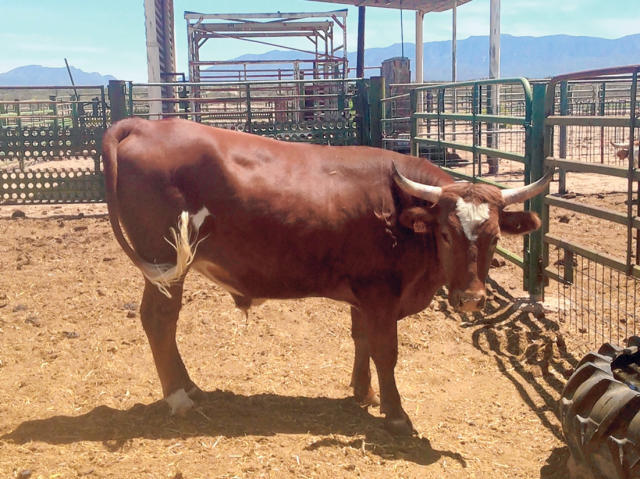
From the Albuquerque Journal
JORNADA EXPERIMENTAL RANGE – The cattle foraging in the desert here boast a unique bloodline: They are believed to be descendants of cattle brought to the Americas by Spanish conquistadors 500 years ago.
They also are believed to be uniquely adapted to survive the increasingly dry climate of the desert Southwest.
Alfredo Gonzalez manages the experimental criollo herd at the U.S. Department of Agriculture’s Jornada Experimental Range, a 300-square-mile research ranch between the Doña Ana and San Andrés mountains in southern New Mexico outside Las Cruces.
Scientists are studying whether these criollo cattle, handpicked from a remote region in Mexico’s Chihuahua state and bred on site – the herd numbers about 500 now – may be better suited than traditional beef cattle to a drought-plagued landscape.
A decade ago, Gonzalez and researcher Ed Fredrickson, formerly of New Mexico State University, found the criollo cattle among the Tarahumara, or Rarámuri, tribe in Chihuahua’s Copper Canyon, a geographic formation twice the size of the Grand Canyon where the indigenous people have lived in relative isolation for centuries. The cattle are known as rarámuri.
“We went all over Mexico looking for an animal that we thought would adapt to a desert area,” Gonzalez said. “We were looking for an animal that can survive.”
Drought has hurt traditional New Mexico cattle ranches, which typically raise British breeds like Angus and Hereford.
The number of cattle and calves raised in New Mexico fell for the fourth year in a row to fewer than 1.3 million head as of January 2014 – 20 percent off the peak of 1.6 million in 2000, according to the USDA’s most recent annual livestock report. The inventory of cattle available for slaughter dropped to 387,000 head at the same time, the lowest inventory on record.
Although rains during last year’s monsoon season allowed ranchers to increase their cattle inventory for the first time in years, the dropoff in herd numbers has been “huge” due to drought conditions, said Longino Bustillos, the USDA’s New Mexico state statistician.
The question is, “How do you partner with nature rather than create a production system counter to nature, which results in spending more money and being less profitable?” said Ann Adams, programs director with Albuquerque-based Holistic Management International, which helps farmers and ranchers increase the sustainability of their operations. “There is no one right answer. But certainly a lot of folks are beginning to recognize they need to match the animal to the landscape.”
The criollo are smaller than Angus or Hereford, more docile and fleet-footed, Gonzalez said. They roam a greater distance without water, rarely stay in one place to graze and eat more diverse forage than the British breeds that dominate the West – positive traits when considering their sustainability in the desert.
But it’s unlikely criollo cattle will replace traditional herds any time soon: The beef industry is built around a certain type of animal, raised to fatten on grain and grow big quickly.
After grazing and “finishing” on feedlots where they are fed a mix of grain and hay, traditional beef cattle are brought to slaughter at 16 or 17 months.
By contrast, the criollo don’t require “finishing” with grain or hay, but Gonzalez grazes his cattle for 30 months, nearly twice the usual time.
A study by NMSU researchers found raising criollo cost 64 percent less than traditional production, but the extended period to produce range-fed animals was found to be a limitation for their use in the commercial market.
Still, two commercial ranches, one in southwest New Mexico and another in southeast Arizona, have been inspired by the project to raise the kind of criollo bred on the experimental range. Both ranches sell directly to consumers at farmers’ markets, natural foods stores and a handful of restaurants, but none yet in Albuquerque.
Susie Eickhoff of Susieville Cattle Co., between Silver City and Deming, has raised criollo cattle since 2009. She and her husband have grown their herd from 42 to about 150 animals. They sell in a handful of specialty stores in southern New Mexico and one Silver City restaurant.
“The idea is that they are desert-adapted, they are easy on the land and they are a gentle breed,” she said of her criollo. “I think there is more need throughout New Mexico for this type of cattle.”
Dennis Moroney of the 47 Ranch in southeast Arizona buys criollo cattle from the Jornada Experimental Range for slaughter about twice a year. He also raises them. He is transitioning his ranch from traditional cattle to exclusively criollo and is about halfway there with a herd of about 200, he said.
“The economics are working for us,” he said. “We’re a profitable ranch with no debt. That is very unusual in our business.”
And then the big question: What does it taste like?
Since traditional beef cows are fattened at the end with grains, fat develops on the outside of their meat “like a rind,” Moroney said. His criollo cows also get fattened but over a longer period of time, distributing the fat throughout the meat, which bears the distinct flavors of his cattle’s desert diet – and his steaks have passed a tenderness test with flying colors, he said.
Chef Michael Difilippantonio moves through 70 pounds of criollo ground beef per week at Criollo Latin Kitchen in Flagstaff. He describes the taste as “quite a bit more gamey than run-of-the-mill beef you’d get at a grocery store.”
“For a lot of customers who have never had criollo or free-range beef, it doesn’t have that sweet corn-fed taste,” he said.
But for those consumers increasingly interested in sustainable, free-range options, it’s a popular choice at his restaurant.
“It’s an acquired taste,” he said. “I think it’s incredible.”

